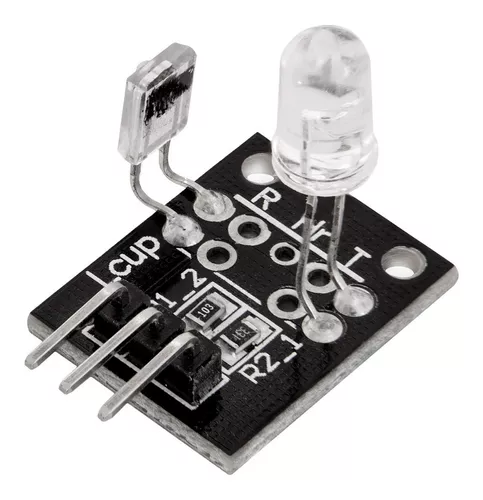[ESP/ENG] 🌟 Módulo de sensor de pulsos cardíacos KY-039: Monitorización del ritmo cardíaco ❤️🩺 🌟 KY-039 Heart Rate Sensor Module: Heart Rate Monitoring ❤️🩺
[ESP]
¡Hola a todos los apasionados de la tecnología y los proyectos biomédicos! 🤖
Hoy vamos a sumergirnos en el fascinante módulo KY-039, una herramienta compacta y económica que te permite monitorear el pulso cardíaco.
💓 ¿Qué es el módulo KY-039?
El KY-039 es un sensor biomédico que detecta el ritmo cardíaco mediante un LED infrarrojo y un fototransistor. Funciona midiendo las variaciones en la intensidad de luz reflejada por el flujo de sangre en el dedo o una parte del cuerpo.

- Características principales:
- Tamaño reducido: Ideal para dispositivos portátiles.
- Detección simple: Emplea luz infrarroja para captar cambios en el flujo sanguíneo.
- Alimentación: Compatible con 3.3V y 5V.
- Salida digital o analógica: Se puede conectar fácilmente a microcontroladores como Arduino.
🛠️ Conexión del KY-039 a un Arduino
El KY-039 tiene tres pines básicos:
- 1️⃣ S (Señal): Conéctalo a un pin analógico del microcontrolador.
- 2️⃣ VCC: Alimentación (3.3V o 5V).
- 3️⃣ GND: Tierra.
Ejemplo de conexión:
KY-039:
S → Pin A0 del Arduino
VCC → 5V
GND → GND
💻 Ejemplo de código en Arduino
A continuación, un ejemplo básico para leer datos del KY-039:

💡 Nota: Los datos en bruto pueden requerir procesamiento adicional para identificar el ritmo cardíaco de forma precisa.
🌈 Aplicaciones del módulo KY-039
- 1️⃣ Monitores de salud portátiles: Diseña un dispositivo para medir el ritmo cardíaco.
- 2️⃣ Proyectos educativos: Introducción a la bioingeniería.
- 3️⃣ Sistemas de fitness: Monitoriza el pulso durante el ejercicio.
- 4️⃣ Integración IoT: Envía datos del pulso a una aplicación móvil o una base de datos.
⚠️ Consideraciones importantes
- 1️⃣ Precisión limitada: No reemplaza equipos médicos profesionales.
- 2️⃣ Condiciones ambientales: Evita interferencias de luz externa.
- 3️⃣ Posición del sensor: Asegúrate de colocar el dedo correctamente para obtener lecturas confiables.
🚀 Reflexión final
El KY-039 es una excelente puerta de entrada al desarrollo de proyectos biomédicos. Con un poco de programación y creatividad, puedes crear sistemas personalizados para monitorizar la salud y explorar la intersección entre la tecnología y el bienestar.
📢 ¡Gracias por explorar conmigo el módulo KY-039! 🌟
Espero que esta publicación inspire tus proyectos biomédicos y tecnológicos. Si tienes preguntas o quieres compartir tus resultados, ¡deja un comentario! 📝
🔔 No te pierdas nuestras próximas publicaciones sobre sensores biométricos y más herramientas avanzadas. 🌐
🤝 Únete a nuestra comunidad para aprender y compartir conocimientos sobre electrónica y salud digital. 💬
🌟 Continúa explorando y desarrollando: Mantente activo en Hive para descubrir nuevas aplicaciones en sistemas biomédicos. ¡Hasta la próxima! 🚀✨
[ENG]
Hello to all the technology and biomedical projects enthusiasts! 🤖
Today we are going to dive into the fascinating KY-039 module, a compact and inexpensive tool that allows you to monitor your heart rate.
💓 What is the KY-039 module?
The KY-039 is a biomedical sensor that detects heart rate using an infrared LED and a phototransistor. It works by measuring variations in the intensity of light reflected by blood flow in the finger or a part of the body.

- Main features:
- Small size: Ideal for portable devices.
- Simple detection: Uses infrared light to detect changes in blood flow.
- Power supply: Compatible with 3.3V and 5V.
- Digital or analog output: Can be easily connected to microcontrollers such as Arduino.
🛠️ Connecting the KY-039 to an Arduino
The KY-039 has three basic pins:
- 1️⃣ S (Signal): Connect it to an analog pin on the microcontroller.
- 2️⃣ VCC: Power (3.3V or 5V).
- 3️⃣ GND: Ground.
Connection example:
KY-039:
S → Arduino pin A0
VCC → 5V
GND → GND
💻 Arduino code example
Here is a basic example for reading data from the KY-039:

💡 Note: Raw data may require additional processing to accurately identify the heart rate.
🌈 Applications of the KY-039 module
- 1️⃣ Wearable health monitors: Design a device to measure heart rate.
- 2️⃣ Educational projects: Introduction to bioengineering.
- 3️⃣ Fitness Systems: Monitor pulse during exercise.
- 4️⃣ IoT Integration: Send pulse data to a mobile app or database.
⚠️ Important Considerations
- 1️⃣ Limited Accuracy: Does not replace professional medical equipment.
- 2️⃣ Environmental Conditions: Avoid interference from external light.
- 3️⃣ Sensor Position: Make sure to position your finger correctly to get reliable readings.
🚀 Final Thoughts
The KY-039 is a great gateway to developing biomedical projects. With a little programming and creativity, you can create custom systems to monitor health and explore the intersection between technology and wellness.
📢 Thank you for exploring the KY-039 module with me! 🌟
I hope this post inspires your biomedical and technological projects. If you have questions or want to share your results, leave a comment! 📝
🔔 Don't miss our upcoming posts about biometric sensors and more advanced tools. 🌐
🤝 Join our community to learn and share knowledge about electronics and digital health. 💬
Congratulations @profwhitetower! You have completed the following achievement on the Hive blockchain And have been rewarded with New badge(s)
Your next target is to reach 18000 upvotes.
You can view your badges on your board and compare yourself to others in the Ranking
If you no longer want to receive notifications, reply to this comment with the word
STOPCheck out our last posts: